Views
Rego Park Homepage | History | Community Information | Contemporary Profile | A "REal GOod Place to Live" | Creative Accent | Domestic Abuse | Conclusion
Contents |
A HISTORY OF REGO PARK
Colonial Times[1]
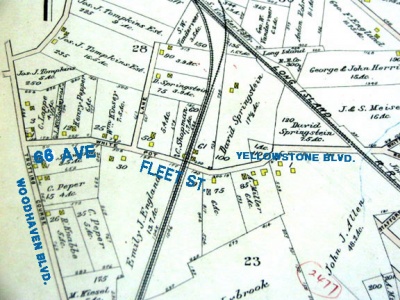
| Rego Park was just farm land until the 1920's. The area was divided among different farming families[2]. |
|---|
In 1653, English and Dutch farmers settled the area that is today called Rego Park and Middle Village. However, at that time, they called it “whitepot”. Some people say it was called this because of the legend that says that the farmers bought this land from the Native Americans for just three white pots. In reality, it was called this from the Dutch word “whiteput”, which means a hollow creek. It was called this because a lot of the area was marshland. When the English came to this area, they anglicized the pronunciation of the name to “whitepot”. A small number of families settled here in 1653 and ran farms. Among them was the Remsen family, the Furman family, the Springsteen family, and the Morrell family. On the farms they grew hay, straw, rye, corn, oats, and many vegetables.

| The Remsen cemetery[3]. |
|---|
During these colonial times, there were very few roads. One road was called Whitepot Road, which is mainly the Yellowstone Blvd of today. Another road was called Remsen’s lane, named after the Remsen family who lived on that road. This road later became 63rd Drive and 64th Road. The Remsen’s had a burial ground on their property that is still around today. Colonel Jacobus Remsen, a hero from the revolutionary war is buried in this cemetery. The families in this area also built a school for themselves, called the Whitepot School, which was open until the early 1800’s.
The 19th Century
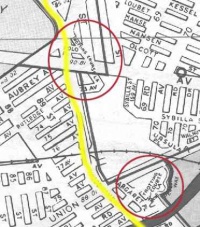
| Trotting Course Lane: The red circles are where pieces of the original road continue to exist today. The yellow line is Woodhaven Blvd[4]. |
|---|
During this time period, a new road, called Trotting Course Lane was created on the Western side of Whitepot. Today, this road is called Woodhaven Blvd. Some pieces of the original Trotting Course Lane continue to exist in the new road today!! One place that some of the original road still exists is along the Western edge of the Remsen cemetery. The name of the street hints to the predominant mode of transportation during the century, which was horse and carriage. However, the reason it was probably named this is because it led to the Union Course, a racecourse[5].
During this time period, Chinese farmers also replaced the Dutch and English farmers that settled the land in the 1600’s. These Chinese farmers created an enclave, and grew vegetables, which they sold exclusively to Chinatown[6].
The Development of Rego Park
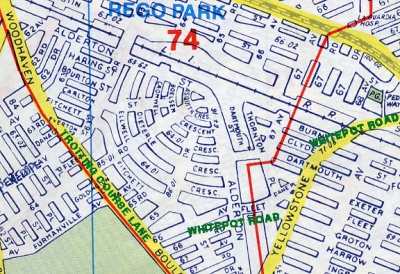
| This is a picture of Rego Park today with some old street names to show the change over time[7]. |
|---|
In 1920, the Real Good Construction Company bought out the farmland and developed the area. In 1923, two of the developers, Henry Schloh and Charles I. Hausmann, renamed the area "Rego" as an advertising slogan, calling it a "REal GOod place to live" and to raise a family. They also named it this after the Real Good construction company, taking the first two letters of the first two words of the company’s name. They started the construction of the city by building 525 8-room houses, each for the price of $8,000. The Real good construction company built single-family homes, multi-family homes, and apartments, attracting many immigrants and natives to the area of Rego Park[8]. The Real Good construction company carved out five crescent shaped streets. They had to make these streets crescents instead of circles, because two lines of the LIRR, the main line and the Rockaway Branch line bordered the crescents. They built many single-family attached and detached homes among the streets of the crescents. They named the streets along the crescent in alphabetical order from A to F. The street names are Asquith, Boelsen, Cromwell, Dieterle, Elwell and Fitchett. They tried to make the names of these streets sound aristocratic, in hopes of attracting wealthier residents [9].
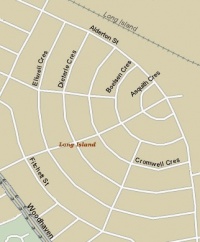
| The crescent streets in Rego Park[10]. |
|---|
In 1926, the first stores were built in Rego Park on Queens Blvd and 63rd Drive. Today, a lot of commerce is done on 63rd Drive. The Real Good construction company built many apartment buildings in 1927 and 1928[11]. In 1929, PS 139 was built on 63rd Drive and Austin St[12]. However, construction became a lot slower in 1929, with the hit of the Great Depression. Construction picked up again in 1939 and 1940, thanks to the World’s fair. The last open land on 99th Street and Queens Blvd became covered in apartment buildings at this time.
Public transportation to the area developed pretty quickly. A railroad station opened up in 1928. The Long Island Expressway was also extended to Queens in 1935. Additionally, in 1936, a subway line was created to Union Turnpike[13]. In the 1930’s, Trotting Horse Lane was renamed to Woodhaven Blvd. The road was also straightened at this time, to better accommodate automobiles. Today, Woodhaven Blvd is an extremely busy street, with 10 lanes![14] (Pic of trotting lane street sign).
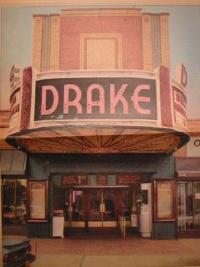
| The Drake Theater[15]. |
|---|
In 1930, a book mobile started to serve Rego Park. In 1938, it became a storefront facility, and finally in 1956, Rego Park got its own library branch. However, in 1972, a fire destroyed the library. In 1975, a new library was built. Between 1972 and 1975, Rego Park was once again served by a book mobile and many residents also used the Forest Hills library branch. In 1989, the Rego Park library went under many renovations[16].
In 1935, the Drake Theater opened in Rego Park. It was located at 62-90 Woodhaven Boulevard and was open until the 90's. The theater usually played double-run performances[17].
Rego Park Today
Since its development in the 1920's, the population of Rego Park steadily increased until the 1970's. During this time, German, Italian, and Irish immigrants poured into the area[18]. In 1970, the population of Rego Park and Forest Hills was 120,429. In 1980, the population dropped to 112,245. In 1990, the population again dropped to 106,996. However, in 2000, the population of Rego Park and Forest Hills increased to 115,967[19]. This sizable increase in the population of Rego Park is due to the Bukharian immigrant group who began coming in large numbers to Rego Park and Forest Hills since the 1990's, when the Soviet Union collapsed. Rego Park has even been nicknamed "Regostan" because of the large Bukharan population.
In 1970, Russian and Chinese immigrants began to replace the earlier Irish, German, and Italian residents. The Russian and Chinese still make up a very large percentage of the Rego park population. There are also small enclaves of Indian, Iranian, Korean, Columbian, and Romanian immigrants. The many different countries of origin of the residents of Rego Park have made the area into a very diverse neighborhood[20].
References
- ↑ Wilkinson, Christina. "Forgotten NY neighborhoods: Crescent City, Rego Park." March 19, 2006. <http://www.forgotten-ny.com/NEIGHBORHOODS/regopark/regopark.html>.
- ↑ Wilkinson, Christina. "Forgotten NY neighborhoods: Crescent City, Rego Park." March 19, 2006. <http://www.forgotten-ny.com/NEIGHBORHOODS/regopark/regopark.html>.
- ↑ Wilkinson, Christina. "Forgotten NY neighborhoods: Crescent City, Rego Park." March 19, 2006. <http://www.forgotten-ny.com/NEIGHBORHOODS/regopark/regopark.html>.
- ↑ Wilkinson, Christina. "Forgotten NY neighborhoods: Crescent City, Rego Park." March 19, 2006. <http://www.forgotten-ny.com/NEIGHBORHOODS/regopark/regopark.html>.
- ↑ Wilkinson, Christina. "Forgotten NY neighborhoods: Crescent City, Rego Park." March 19, 2006. <http://www.forgotten-ny.com/NEIGHBORHOODS/regopark/regopark.html>.
- ↑ Seyfried, Vincent. Rego Park. The Encyclopedia of New York City Edited by Kenneth T. Jackson. New Haven, Yale University Press. 1995.
- ↑ Wilkinson, Christina. "Forgotten NY neighborhoods: Crescent City, Rego Park." March 19, 2006. <http://www.forgotten-ny.com/NEIGHBORHOODS/regopark/regopark.html>.
- ↑ Seyfried, Vincent. Rego Park. The Encyclopedia of New York City Edited by Kenneth T. Jackson. New Haven, Yale University Press. 1995.
- ↑ Wilkinson, Christina. "Forgotten NY neighborhoods: Crescent City, Rego Park." March 19, 2006. <http://www.forgotten-ny.com/NEIGHBORHOODS/regopark/regopark.html>.
- ↑ Wilkinson, Christina. "Forgotten NY neighborhoods: Crescent City, Rego Park." March 19, 2006. <http://www.forgotten-ny.com/NEIGHBORHOODS/regopark/regopark.html>.
- ↑ Seyfried, Vincent. Rego Park. The Encyclopedia of New York City Edited by Kenneth T. Jackson. New Haven, Yale University Press. 1995.
- ↑ "Rego Park Community History." Queens Library. 12 March 2009 <http://www.queenslibrary.org/index.aspx?page_nm=CL-Communityinfo&branch_id=RG&#clhistory>
- ↑ Seyfried, Vincent. Rego Park. The Encyclopedia of New York City Edited by Kenneth T. Jackson. New Haven, Yale University Press. 1995.
- ↑ "Forgotten NY street scenes: Woodhaven 'Trotting Course'." <http://www.forgotten-ny.com/STREET%20SCENES/Trotting/trotting.html>
- ↑ Wilkinson, Christina. "Forgotten NY neighborhoods: Crescent City, Rego Park." March 19, 2006. <http://www.forgotten-ny.com/NEIGHBORHOODS/regopark/regopark.html>.
- ↑ "Rego Park Community History." Queens Library. 12 March 2009 <http://www.queenslibrary.org/index.aspx?page_nm=CL-Communityinfo&branch_id=RG&#clhistory>
- ↑ "Cinema Treasures: Drake Theater" <http://cinematreasures.org/theater/4614/>
- ↑ Seyfried, Vincent. Rego Park. The Encyclopedia of New York City Edited by Kenneth T. Jackson. New Haven, Yale University Press. 1995.
- ↑ Population Division - New York City Department of City Planning. <www.nyc.gov/html/dcp/pdf/census/cdsnar.pdf>
- ↑ Seyfried, Vincent. Rego Park. The Encyclopedia of New York City Edited by Kenneth T. Jackson. New Haven, Yale University Press. 1995.